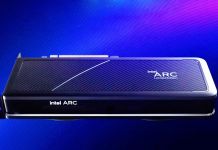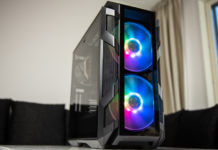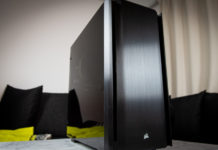Antec MicroFusion 350 was the microATX version of the Fusion 430, and MicroFusion 350 Remote is an updated version, answering some of the calls from the HTPC community. We look at what it all adds up to in this review.
Veris Fusion is the name of Antec’s line of cases designed for HTPCs, also known as Media Center PCs, named after Microsoft’s Media Center operating system. HTPC is short for Home Theater Personal Computer and it is a fast expanding market, at least here in Europe. An HTPC case can have many appearances, but since HTPCs are used for home entertainment playing videos, music and presenting pictures, most of them are lying down.
The biggest difference is of course that this is not a case that will be seated on top of your desk, but among your home theater electronics. Therefore most HTPC cases also look a bit like it belongs there, with traits similar to those of a receiver or DVD-player. HTPC enthusiasts are usually picky about the looks of their equipment, and by that I foremost mean their electronics, and that includes the HTPC nowadays.
An HTPC has to be clean and stylish, with many outputs for audio and video. The latter is of course largely reliant on the hardware you put in there, but there are still a certain amount of connectors that the case should have. Antec Veris MicroFusion 350 Remote is the very latest microATX HTPC case from Antec. It is an updated version of Veris MicroFusion 350, now with a Remote.
Let’s look at the specifications.
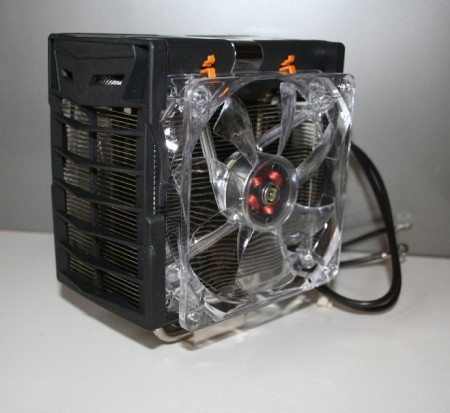 |
|
|
Antec Veris MicroFusion 350 Remote
|
|
| Case: | HTPC |
| Top panel: | Perforated bezel |
| Measurements (HxWxD): | 12 x 39 x 41cm 4.5″ x 15.1″ x 16.1″ |
| Weight: | 11.3lbs / 5.1kg |
| Motherboard support : | microATX |
| Cooling (fans): | Right – 2x 80mm (cools the big chamber) Left – 1x 80mm (cools harddrive) |
| Material: | 0.8mm cold rolled Steel |
| Internal units: | 1×3.5″ |
| External units: | 1×5.25” |
| Expansion slots: | 4 |
| Power supply | Antec MT-350 350 Watt power supply, 80 Plus Certified |
| Color: | Black & Silver |
| Other: | LCD (Windows MCE/Vista compatible) USB, eSATA, mic and headphone connectors on the front Screws and extra brackets for the harddrives, optical units and fans. Cable ties Manual Driver CD IR Remote (receiver is in the LCD) Power cord |
| Price: | ~$190 |
Another thing, beside the aesthetics, that is especially important for HTPC enthusiasts is noise. If the fans are too loud they will either reduce the case to worthless or the fans will be replaced if the rest of the case still holds enough quality. This is also why most HTPC cases don’t have fans from factory, to enable the user to use his own favorite fans. Antec has chosen to send along fans of its TriCool series though. Unfortunately the only of the three settings that is even close to acceptable is the lowest. Alas, the fastidious HTPC users are most likely going to replace them.
|
Antec TriCool 80 mm
|
|||
|
RPM
|
Airflow (CFM)
|
Noise (dB(A))
|
Power (W)
|
|
2600
|
34
|
30
|
2.4
|
|
2000
|
26
|
24.3
|
1.8
|
|
1500
|
20
|
18
|
1.2
|
The power supply is 80Plus verified with a peak efficiency of 83% during 50% load and 80% efficiency during full and 20% load.
|
Antec MT350 – 350W
|
||||||
|
Voltage
|
+3.3V
|
+5V
|
+12V1
|
+12V2
|
-12V
|
+5VSB
|
|
Max. load
|
20A
|
20A
|
18A
|
18A
|
0.8V
|
2A
|
|
Min. load
|
0.3A
|
0.5A
|
1A
|
1A
|
0A
|
0A
|
| Comb. load |
25A (300W)
|
|||||
|
Regulation
|
±5%
|
±5%
|
±5%
|
±5%
|
±10%
|
±5%
|
|
Ripple & Noise
|
50mV
|
50mV
|
120mV
|
120mV
|
120mV
|
50mV
|
The accessory box was not filled with the same amount of plentiful things we’re used to with cases from Antec, but it still holds the most essential of things, like screws, cable ties, manual, driver CD, warranty information, and last but certainly not least the remote.
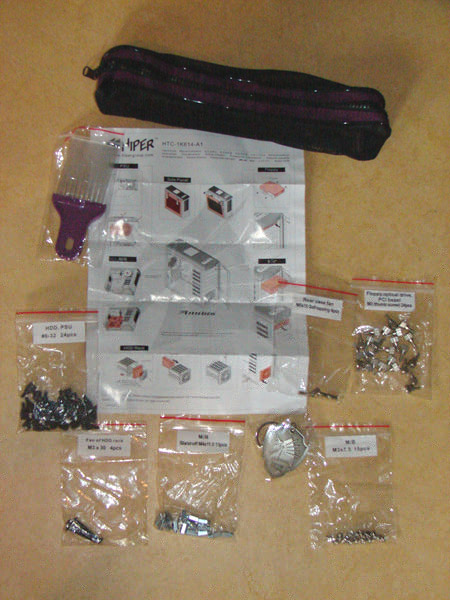 |
As you can see the remote is anything but large. It’s actually quite petite and that surprised me. I was expecting a full size remote to match my other remotes, sadly I have way too many as it is already. A remote is a great idea, but I think Antec should have made it full-size to look like a regular remote, even though most of the content of the remote will be empty space, it’s a design thing, and as I’ve mention so many times already, this is a crucial thing for HTPC enthusiasts.
Let’s have a look at the exterior.
The frame of Antec VERIS microFusion 350 Remote is made from steel, while the front bezel is made from high quality aluminum, and it really does feel like high quality. I have both a CD player and an amplifier from the Classic series by Beijing Yushang Audio with bezels made from the same kind of aluminum, which means that this should blend well with my equipment at least.
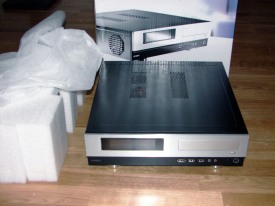 |
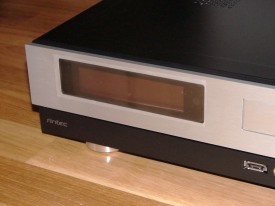 |
to another writer for another type of article after this review.
The LCD is clear when on and not at all hard to read from the couch. Antec says that the LCD was designed to work with Windows MCE (Media Center Edition) and Vista. It can show system information, media information, e-mail check, news feeds, weather reports, and graphic audio equalizer.
The door for the optical drive folds down in a steady motion that does give you the feel of a quality build. Remember to use an optical drive with a black front and sled though, otherwise it won’t match. The ports on the front are always visible, which of course have its pros and cons, but most users prefer hiding them behind a hatch. They are not too disruptive of the overall design though.
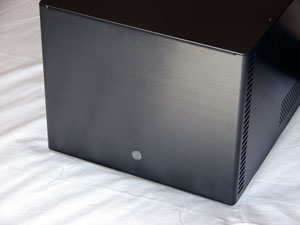 |
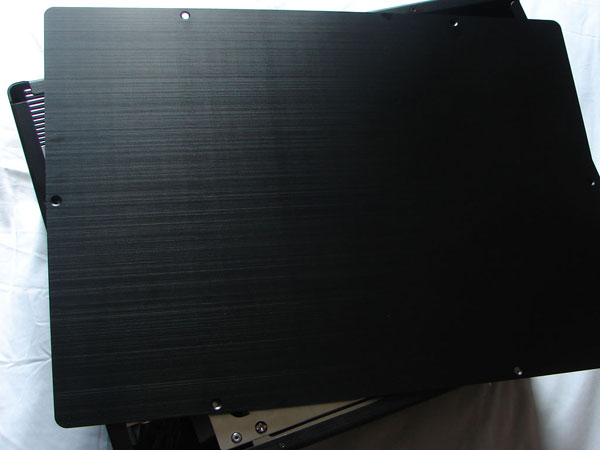 |
The top has two perforated opening that let the hardware breath. Cool, fresh air can enter and hot air can leave the case. On the right side, when seen from the front, we have two 80mm Antec TriCool fans that cool the components inside the big chamber, I.e. motherboard, processor and graphics card most importantly.
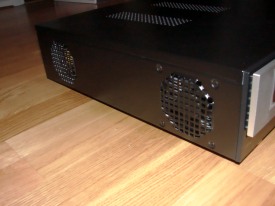 |
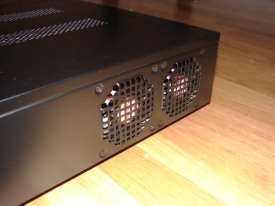 |
On the left side there are also two fans. The front one is another 80mm Antec TriCool fan that cools the harddrive, while the rear fan is the fan of the 350W power supply.
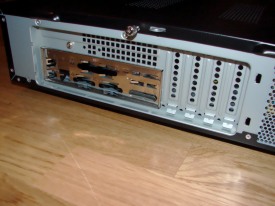 |
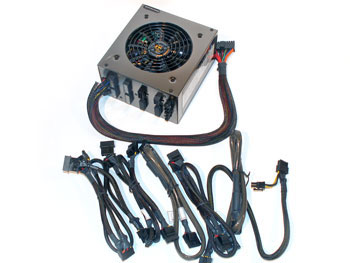 |
The rear is pretty clean as well. The standard I/O bracket in place and the four expansion slots with perforated steel brackets. On the right we have the small 350W PSU that should be sufficient for any HTPC hardware configuration. On the next page we go inside.
This is usually were I take tons of pictures to catch every little detail the manufacturers throw in there. I didn’t have to this time, not because it lacked creativity or innovative features, but the case is so small and well planned that you could easily cover most of them with just a few shots.
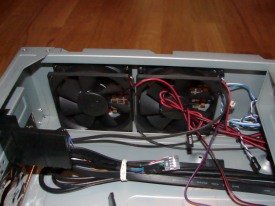 |
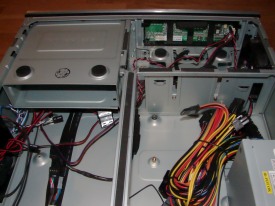 |
On the left you see the two fans that cool the main chamber. You also see the support that you can adjust the size of with additional black plastic pieces, and the cables for the eSATA and USB ports on the front. Beneath the drive bay for the optical drive are the blue wires for the HDD LED and reset button. The power button is not seen because it goes directly to the LCD. This is so that you can power on the system using the remote.
To the right is an overview of the case with the optical drive bay to the left, the harddrive bay on the top right and the power supply on the lower right. This picture was taken from behind the case. The cables from the power supply are plentiful and can power more things than you can actually fit inside of the case. The two chamber structure should make cooling a lot more efficient as the components will not heat up each other, which in turn should lead to a quieter PC.
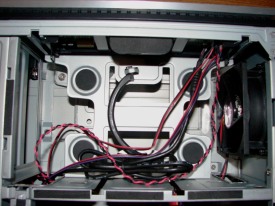 |
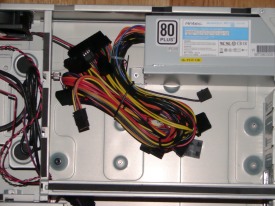 |
To the left we have the harddrive chamber seen from above, which comes with a real mess of cables from factory. They are the cables going to and from the LCD. The harddrive installation is not as easy as one would have liked though since you have to remove the LCD, two screws and then lift out the bay using the black handle. The LCD is not especially hard to remove, or get back in place, it just feels like a minor annoyance. You simply push in the black plastic locks on each side and the LCD snaps out.
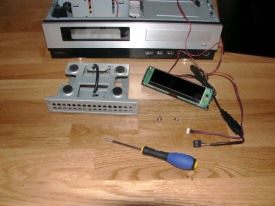 |
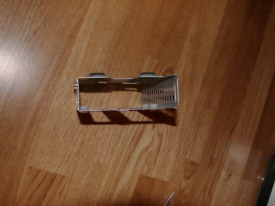 |
Here you see the LCD out of the case and the harddrive bay and its silicone supports. The installation may not be tool-free, but we prefer this approach since tool-free designs are rarely as precise and able to reduce vibrations and noise as well as these kind of designs.
Since this case has some more features that doesn’t quite fit on any of the previous pages I decided to spend a page on the remote and how it and the case blends (in the aesthetic sense, not the chop into pieces sense).
The remote may be small but it fits nicely into the hand, so it is not too small. The buttons are soft but responsive. It was more or less specifically designed for iMEDIAN HD by SoundGraph. You will find the software on the included CD, or you can download it from SoundGraph’s website. Unfortunately, we didn’t have time to test the compatibility with other media applications. The battery compartment is easy to access through the sliding mechanism, real easy to switch batteries.
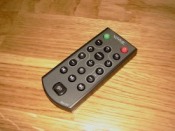 |
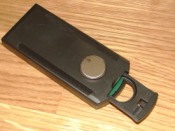 |
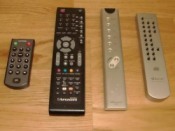 |
On the bottom of the remote is the go button that will start up the iMEDIAN HD application, while the rest are rather self explanatory from their symbols. Browsing the media interface is fairly quick and shouldn’t pose a problem. We would have liked to try it with Media Portal, but there wasn’t time before publishing.
As we mentioned back on page 2, the remote is a bit small, clearly shown by the picture above. Although, I do admit it is not entirely fair to compare it to two of the most fantastic remotes ever built in terms of quality, while it does fit better with the remote for my Hyundai ImageQuest TV. The case does fit with my other equipment though. I placed it on the floor beneath the TV unit and took a picture when sitting on the couch writing this review.
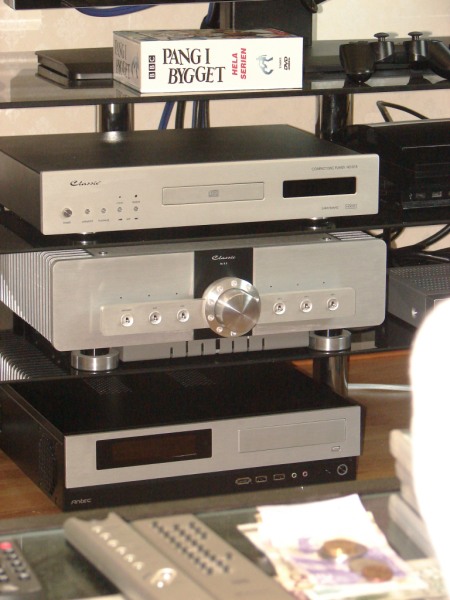 |
(Pang i bygget = Fawlty Towers)
I’ve tested a lot of cases in my days, and I’ve come in contact with even more through my work at various events. I’ve always regarded Antec as one of the top manufacturers in terms of innovativity and build quality. Antec MicroFusion 350 Remote doesn’t change my opinion for better or for worse. It’s an Antec case delivering what it promises. It has the same features as most Antec cases; removable harddrive bay, silicone supports to reduce vibrations, 80Plus certified power supply, a clean design, but also the now rather tiresome drawback: loud fans. Even though the fans have three settings, only the lowest is bearable.
The cooling potential is excellent though. The power supply has its own fan for cooling, while the motherboard and processor is cooled by the two 80mm fans on the right side. The harddrive has separate cooling. The two chamber design has enabled also this case to run both cool n’ quiet. The case is made from steel, but to be honest I think it would have much to gain from an aluminum construction, since it is already light and needs the rigidity.
The layout is a display of Antec engineering at its best. The two chambers are what makes this case. There are silicone support that make sure the top panel doesn’t vibrate and keep the harddrive from causing any noise at all. The only thing we feel is not really top-notch here is that you have to remove the LCD to install the harddrive. To me it seems like the harddrive chamber could be move a centimeter out from the front and thus eliminate the whole LCD removal process. On the other hand, you have to do this only once so it’s not a big deal because it is not very hard to do, it’s actually quite easy.
As you may have guessed the main objection here is the fans, otherwise we feel that this is a good case. Maybe it would have been nice with room for another harddrive, there looks to be room for one, but since this is the micro version of the Veris Fusion series, it delivers as promised. The price is at the same level as similar cases and with the new remote it has a slight edge compared to other similar cases.
 |
|
Antec Veris microFusion 350 Remote
|
|
Pros Cons |
I want to thank Antec and Sarah Berndtsen at LewisPR for sending over the case.


